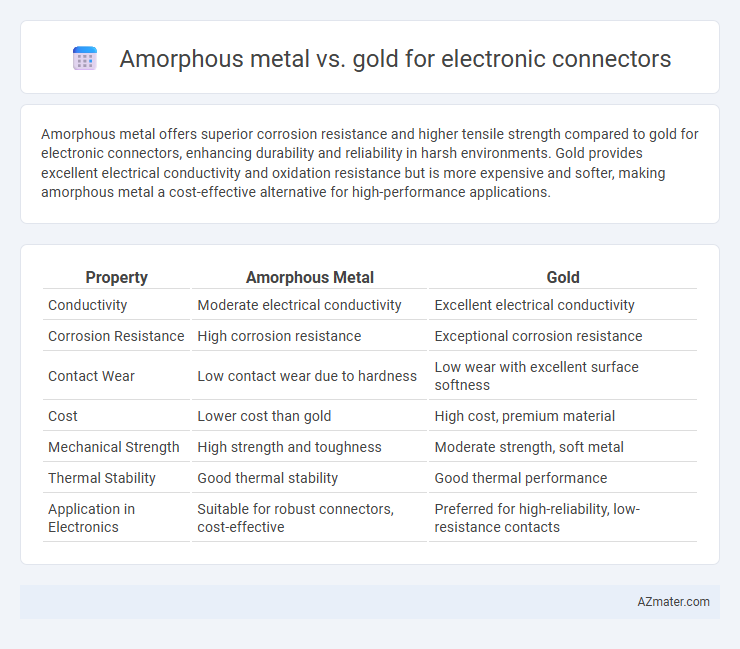Amorphous metal offers superior corrosion resistance and higher tensile strength compared to gold for electronic connectors, enhancing durability and reliability in harsh environments. Gold provides excellent electrical conductivity and oxidation resistance but is more expensive and softer, making amorphous metal a cost-effective alternative for high-performance applications.
Table of Comparison
| Property | Amorphous Metal | Gold |
|---|---|---|
| Conductivity | Moderate electrical conductivity | Excellent electrical conductivity |
| Corrosion Resistance | High corrosion resistance | Exceptional corrosion resistance |
| Contact Wear | Low contact wear due to hardness | Low wear with excellent surface softness |
| Cost | Lower cost than gold | High cost, premium material |
| Mechanical Strength | High strength and toughness | Moderate strength, soft metal |
| Thermal Stability | Good thermal stability | Good thermal performance |
| Application in Electronics | Suitable for robust connectors, cost-effective | Preferred for high-reliability, low-resistance contacts |
Introduction to Electronic Connector Materials
Amorphous metals and gold are critical materials in electronic connector manufacturing due to their unique electrical and mechanical properties. Amorphous metals offer superior corrosion resistance, high strength, and excellent wear resistance, enhancing connector durability in harsh environments. Gold provides exceptional conductivity and oxidation resistance, ensuring reliable signal transmission and longevity in electronic connectors.
Overview of Amorphous Metals
Amorphous metals, also known as metallic glasses, exhibit a non-crystalline atomic structure that provides superior hardness, corrosion resistance, and wear properties compared to traditional crystalline metals like gold. Their unique structure allows for high strength-to-weight ratios and excellent electrical conductivity, making them ideal for electronic connectors where durability and reliable signal transmission are critical. Unlike gold, which offers exceptional corrosion resistance and conductivity but is softer and more expensive, amorphous metals present a cost-effective alternative with enhanced mechanical performance in demanding electronic connector applications.
Properties of Gold in Electronics
Gold exhibits exceptional corrosion resistance and excellent electrical conductivity, making it ideal for electronic connectors where reliable signal transmission and long-term durability are critical. Its resistance to oxidation prevents contact degradation, ensuring stable performance in harsh environments and high-frequency applications. Compared to amorphous metals, gold provides superior solderability and consistent low contact resistance, which are essential for precision electronic components.
Electrical Conductivity Comparison
Amorphous metals generally exhibit lower electrical conductivity compared to gold, with typical values around 1.0-1.5 x 10^6 S/m versus gold's high conductivity of approximately 4.1 x 10^7 S/m. Gold's superior conductivity and resistance to oxidation make it the preferred material for electronic connectors requiring reliable signal transmission and minimal contact resistance. Despite amorphous metals offering excellent mechanical properties, gold remains unmatched in electrical performance for connector applications.
Mechanical Durability and Wear Resistance
Amorphous metals exhibit superior mechanical durability and wear resistance compared to gold when used in electronic connectors, due to their non-crystalline atomic structure that enhances hardness and reduces deformation under stress. Gold, while excellent for corrosion resistance and electrical conductivity, tends to suffer from mechanical wear and deformation in high-friction environments. Consequently, amorphous metals offer a more robust solution for connectors requiring prolonged mechanical reliability and resistance to surface degradation.
Corrosion and Oxidation Resistance
Amorphous metals exhibit superior corrosion and oxidation resistance compared to gold in electronic connectors due to their unique non-crystalline atomic structure, which reduces grain boundaries and potential corrosion sites. While gold naturally resists oxidation and remains conductive over time, it is softer and prone to mechanical wear, potentially compromising connector integrity. Amorphous metals combine high corrosion resistance with enhanced mechanical strength, offering longer-lasting protection in harsh electronic environments.
Cost Analysis: Amorphous Metal vs Gold
Amorphous metal connectors typically offer a cost advantage over gold due to lower raw material and manufacturing expenses, reducing overall production costs by up to 50%. Gold connectors, while expensive with fluctuating market prices averaging around $60 per gram, provide superior corrosion resistance and conductivity, often justifying the higher investment in high-reliability electronics. The cost efficiency of amorphous metals makes them a viable alternative for large-scale or cost-sensitive electronic connector applications without significantly compromising performance.
Contact Performance and Reliability
Amorphous metal connectors exhibit superior contact performance and enhanced reliability compared to gold connectors due to their higher hardness and resistance to wear, corrosion, and fretting. Unlike gold, which is soft and prone to deformation under mechanical stress, amorphous metals maintain stable contact resistance and resist oxidation, leading to longer connector lifespan in harsh environments. These properties make amorphous metal an ideal choice for high-reliability electronic connectors requiring consistent electrical performance over multiple mating cycles.
Application Suitability in Modern Electronics
Amorphous metals exhibit superior wear resistance, high strength, and corrosion resistance compared to gold, making them highly suitable for electronic connectors subjected to harsh environments and mechanical stress. Gold offers excellent electrical conductivity and oxidation resistance, ideal for connectors requiring stable signal transmission and minimal contact resistance in sensitive applications. Modern electronics benefit from amorphous metal connectors in rugged devices, while gold remains preferred for high-reliability connections in telecommunications and precision instrumentation.
Future Trends and Technological Advancements
Amorphous metals exhibit superior resistance to wear and corrosion compared to gold, making them promising candidates for next-generation electronic connectors with enhanced durability and reliability. Advanced manufacturing techniques, such as additive layering and precision alloy engineering, are driving the integration of amorphous metal connectors in high-frequency and high-temperature applications. Future trends emphasize reducing dependency on precious metals like gold by leveraging amorphous metals' cost-effective sustainability and improved electrical performance in miniaturized electronic components.

Infographic: Amorphous metal vs Gold for Electronic connector
 azmater.com
azmater.com